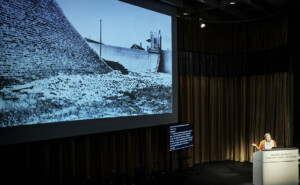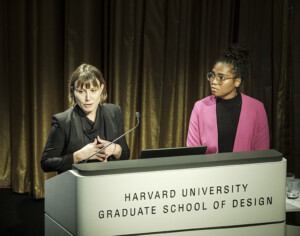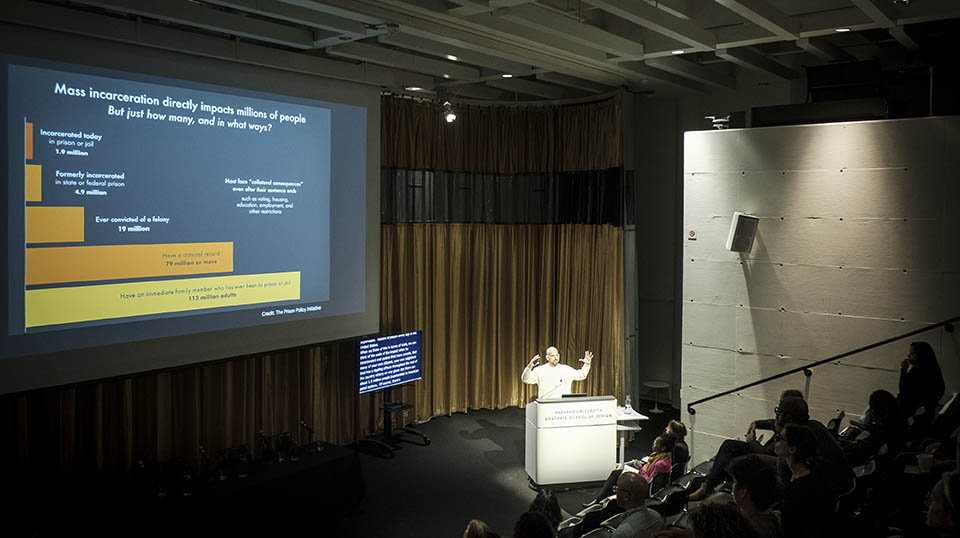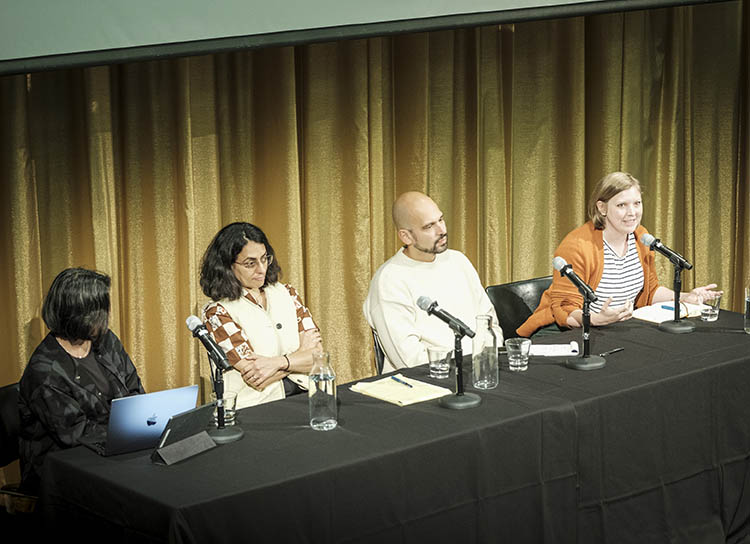
A photograph from the 1950s depicts Chicago’s Cook County Jail in a fragile state. An imposing wall had crumbled, leaving bricks—many of which were produced by inmates themselves—scattered in the yard. Melanie Newport, Associate Professor of History at the University of Connecticut, shared the image as part of “Carceral Landscapes,” a symposium at the Harvard Graduate School of Design in October that aimed to foreground the role of architects, designers, and planners in confronting mass incarceration in the United States. The photo of the jail in ruins served as an evocative touchstone for discussion throughout the event. Speakers and audience members alike reflected on the imposing facilities designed by architects to detain millions of people as well as the effort required to unmake that architecture.
Organized by GSD faculty members Lisa Haber-Thomson, Lecturer in Architecture, and Dana McKinney White, Assistant Professor of Urban Design, and co-sponsored by Harvard Law School’s Institute to End Mass Incarceration, the symposium focused on the physical infrastructure of incarceration, highlighting its histories and present conditions as a step toward dismantling an oppressive system. As Newport said, “the gradual escalation of mass incarceration happened brick-by-brick.” Bringing legal expertise and sociological studies together with research on the built environment, the symposium sparked an interdisciplinary conversation about a social problem with multilayered origins and impacts.

“We as designers are culpable in part for the issue of mass incarceration in America,” McKinney White explained in an interview, noting the active role that architects, including major firms, have played in building prisons and jails. “It’s critical that this conversation take place at the GSD because we are in a very influential position,” McKinney White continued, “not just as a school of architecture, landscape architecture, and planning and urban design, but also as a part of Harvard, where conversations about mass incarceration are happening at the Law School and at the Kennedy School of Public Policy. This is a moment of leaning into that conversation and actively talking about our role in it.”
The scope and urgency of the problem became clear through a series of bracing charts shared by Andrew Manuel Crespo, Morris Wasserstein Public Interest Professor of Law at Harvard Law School and Executive Faculty Director of the Institute to End Mass Incarceration. With a per capita incarceration rate dwarfing that of other developed nations, the United States carceral system is an extreme outlier among peer countries. On any given day, nearly 2 million people are incarcerated in US facilities, and millions enter the system every year. Mass incarceration impacts an astonishing number of people: Crespo estimated that the half of Americans have been affected, either by entering the system themselves, living under supervision of a criminal justice system, or having an immediate family member who has. As a phenomenon, mass incarceration is both a widespread and hyper-focused, disproportionally impacting people of color and those living below the poverty line.
While the present justice system may seem intractable, buoyed by appeals to public safety, Crespo emphasized that mass incarceration is a recent phenomenon. Incarceration rates started to spike only in the 1970s and peaked in 2009. Over that time, confinement became a “backstop for problems we can tie to social conditions and social inequality.” He described the need to end mass incarceration as a “radical obvious idea,” one that would require a direct confrontation with deep social problems rather than a continued reliance on carceral “solutions.”

While lawyers and law enforcement officials animate the criminal justice system, architects had a crucial role in creating it. Haber-Thomson introduced the symposium with a critical history of the emergence of carceral architecture. She noted how studies by Michel Foucault and Robin Evans have shaped contemporary perspectives on how modern prison building typologies, including the notorious panopticon design, emerged in industrializing Europe at the end of the eighteenth century. Haber-Thomson argued, however, that such histories of prison must now be augmented by the recognition of longer continuities between mass incarceration and enslavement.
The full history of incarceration is a daunting account of oppression. But it also reveals moments of subversion and strategies of resistance that people in the present can recover. “Every history of these spaces contains contestation,” Newport said. Her study of the Cook County Jail, the largest single-site jail in the country, shows that the facility is far from monolithic and stable. Instead, it contains heterogenous architecture and variable land use patterns that reflect evolving ideas about the role of the jail in society. At times, Newport detailed, “jailed people maintained a degree of public visibility,” with information flowing in and out of the structures. Though increasingly isolated today, Newport emphasized the importance of moments of “porousness,” which exist in living memory, as productive counterpoints to the present.
Some particularly dysfunctional jail facilities in urban centers have attracted national attention, notably Riker’s Island in New York and Men’s Central Jail in Los Angeles. While acknowledging the struggles at these sites, Sarah Lopez, Associate Professor at the University of Pennsylvania in the Stuart Weitzman School of Design, drew attention to the rapid expansion of migrant detention facilities in Texas, which have received relatively little public scrutiny. For those constructing this carceral infrastructure aimed at migrants, “remoteness and invisibility is like a science,” Lopez said. Difficult for journalists and activists to access, these facilities are also embedded in rural communities with few other economic prospects. The promise of revitalizing rural areas is one selling point for the prison industry, though Lopez noted that the anticipated benefits rarely materialize, with profits extracted by major companies. Still, the dependency of rural political districts on the detention economy helps perpetuate the system overall.
How can designers hope to make a difference in these conditions? Crespo noted that the infrastructure built during the prison boom of the 1980s is now aging, with some facilities reaching the ends of their anticipated lifecycles. According to Crespo, architects may have an opportunity to force a change by withholding their expertise, essentially letting the walls of jails crumble, like those in Newport’s photograph. In this environment, disputes about “vocational ethics” will surely arise within the field. Crespo mentioned a pressing example: Should designers help make jails and prisons more humane, for example by bringing the facilities into compliance with the Americans with Disabilities Act? Or should the sole focus be on arguing against the incarceration of disabled people in the first place?

The time for pondering such ethical quandaries may be running out, Lopez suggested. She pointed to the rapid pace with which carceral facilities can be constructed in Texas, with sites for more than a thousand detainees erected in as little as a year. She sees a “dystopian future” of scaled-up, dehumanized imprisonment already coming into existence while the architecture profession lags behind. Only in the past few years, Lopez noted, did the American Institute for Architects ban designing for execution facilities and solitary confinement.
As McKinney White said, however, “until we see more development in solution-building, we’re going to have to try out lots of different approaches, innovate, and be willing to go out on a limb with ideas that may not always be favorable.” Such innovations are the subject of respective courses at the GSD that she and Haber-Thomson will lead to foster further discussion among GSD students. The symposium included a workshop for students focused on the writings of imprisoned people and their experiences with architecture, a project that Rachel Fischer, a first-year MUP student, discussed during a brief presentation.
The symposium was a call for designers to stay engaged in finding alternatives to mass incarceration. Far from an abstract problem, the system comprises concrete spaces that are inhabited by people and situated in communities, and that have transformative effects on the land. Still, just as architects and designers played a role in building this infrastructure, the symposium suggested that they can be unbuilt just as readily. As Crespo said, invoking the crumbling walls of Cook County Jail, “things that seem inevitable feel that way until the moment when they aren’t.”